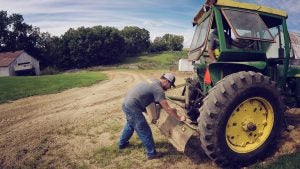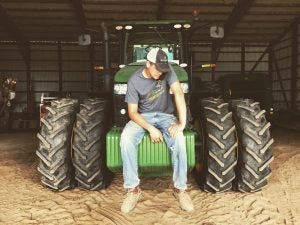Whether it’s leaning halfway out of the cab, crawling up a grain bin, or riding on the top of a 90-foot harvester, Ryan Kuster always gets the shot. He has to … if wants to show his weekly global audience just exactly how farms work.
Kuster owns and operates the dynamic YouTube channel, How Farms Work, which showcases his family’s beef and crop operation in Southwest Wisconsin. Since his first video aired in 2012, Kuster has posted more than 380 videos to the channel. His current subscriber base is 50,083 and counting.
How Farms Work has become a YouTube sensation, but Kuster admits his fame from farming didn’t come overnight, but from humble beginnings.
“Ever since I was a kid, I’ve been involved on the farm,” Kuster said. “I have always been involved in agriculture and always been around the tractor, working, fixing stuff.”

Kuster grew up helping out on his grandparents’ 70-head dairy farm in Wisconsin. When his grandfather passed in 2014, the family transitioned to beef and crops. After graduating in 2015 from the University of Wisconsin-Platteville with a degree in agricultural business, it was only a natural choice for Kuster to return to the family farm.
But Kuster has always had another passion besides farming — photography. An entrepreneur at heart, Kuster saved up his money for a small Canon Rebel and started his own photography business right after his high school graduation.
“I learned the business aspect of it and how to handle working with people as well as composure,” Kuster said. “I’ve never stopped learning.”
Today Kuster’s equipment includes two DSLRs and a camera video stabilizer. People often ask him if he is with the news when he is hauling his professional equipment around in public.
His move from photography to cinematography happened in 2007 when Kuster first started his YouTube account and uploaded a couple videos from around the farm.
“I noticed that within a few years, they had gotten 15,000 views. That was quite a few views, given at the time, there were not all that many farming videos on YouTube,” Kuster said. “I thought maybe if I started uploading more regularly over time, they will accumulate, and more people will start to see how farms work.”
At first Kuster posted only one to two videos a month, then one a week and now he is up to four or more. This week alone he has posted videos on transferring corn for feed, his list of repairs he needs to make around the farm, how to charge a dead car battery and how to spread a load of gravel over a pond in the machine shed. All of the films are first-hand accounts given by Kuster.

“Most of the ideas I have are just taken directly from what we are doing on the farm that day. If we have a big project coming up, like putting a fence in … not a lot of people know how farmers actually do it so I will record it,” Kuster said. “Tractors working out in the field, the animals — how and what we are feeding them. It’s always changing, so it’s not like I will run out of ideas.”
From the 20 to 30 minutes of professional footage Kuster gets, he then spends two to three hours editing each video in the evenings. His brother and dad often appear in the videos and his girlfriend manages online content distribution across the social platforms.
The feedback from How Farms Work has been positive. The YouTube channel has garnered interest from people who don’t farm as well as from farmers. Teachers play the videos at school in ag education classes, and some parents even play them for their children as a bedtime routine. His most popular video on the site is Teaching Her To Drive A Tractor! His rewind Daddy Won’t Sell The Farm is the second-most popular on the channel.
Kuster said if asked, he would consider hosting the show on a network TV channel in the future. In the meantime, he is busy getting ready for new shows this harvest. The farm is adding a tether to the hay cutting so Kuster is looking forward to explaining how that works. Kuster is also getting new camera equipment.
For farmers who want to make their own YouTube videos, Kuster has some advice.
“Start off small. Don’t get too into it until more people start to watch. If you are going to put on a video, try to keep it under four minutes so that way people don’t get bored and will want to come back,” Kuster said. “As you create content, they have a timeline in their mind of happenings on the farm, and what I like to call continuity … where if they watch one video and then you post another video of something where they see something in the background from the first video. … People will start to get more involved and they will feel like they are a part of it.”



